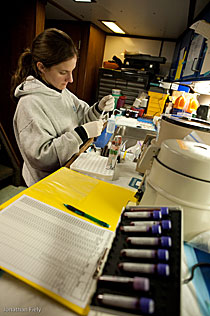Harbor Seal Research
Biological Sampling

We collect several biological samples from each harbor seal we capture. A laboratory is set up and several tests are run on blood and serum on board the research vessel, while the other samples are preserved and either shipped to collaborators (Alaska Sea Life Center [ASLC], University of Wyoming [UW], and University of Alaska – Fairbanks [UAF]) or stored for future analysis.
The biological samples collected from most animals include the following:
- Blubber — blubber is analyzed for fatty acid content, to estimate the diet of the seal over the past several months (ADF&G); blubber is also analyzed for contaminant levels, allowing us to compare contaminant levels across different areas, different species, etc. (ASLC).
- Skin — genetics. Sent to a collaborator, used to assess population stock structure (how much movement of individuals occurs between areas, regions etc.).
- Hair and whisker — used for stable isotope analysis; this is a different way to look at the diet, it gives a trophic-level signature instead of fatty acids from the blubber. Different tissues can be used to look at the diet over different time frames: hair and whisker = during molt when new hair is grown, red blood cells = previous 2–3 months, serum = previous 2–3 weeks (UW, ADF&G). These samples can also be used to assess concentrations of heavy metals (UAF).
- Blood — serum and plasma are used for several tests that assess health; i.e., serum chemistries, disease screening, stable isotopes, D2O concentration, hormone levels, contaminants, etc. Some samples are archived for future research questions that are not yet defined (ADF&G and ASLC).
- On-board laboratory:
- White blood cell counts – high levels indicate current infection, low levels indicate chronic infection. Could also be influenced by stress, contaminant levels or disease.
- Blood smears – used to look at different types of white blood cells; different percentages of different types of white blood cells can indicate what is causing the animal to have an abnormal white blood cell count.
- Hemoglobin – measures the amount of hemoglobin per given volume of blood. Hemoglobin binds to oxygen on the red blood cells and is therefore linked to diving ability. A low hemoglobin in conjunction with a decreased red blood cell count (i.e., a low hematocrit) can indicate anemia.
- Hematocrit – measures the proportion of serum to packed cells. A low serum proportion would indicate dehydration.
- Total protein – measures the protein content of the serum (serum proteins = albumin and globulin). Generally reflects health of animal.
- Notation of lipemic serum – lipemic serum is milky instead of clear; lipemia indicates the presence of lipids and triglycerides in the serum and indicates that the animal recently ingested a meal.
This study has been conducted under MMPA NMFS permit #s 1000, 358-1585 and 358-1787. ADF&G = Alaska Department of Fish and Game, ASLC = Alaska Sea Life Center. For additional information concerning this project, contact Shawna Karpovich at (907)459-7239 or email shawna.karpovich@alaska.gov.
